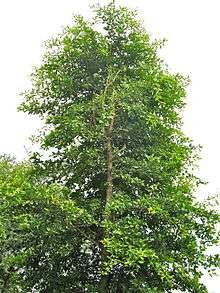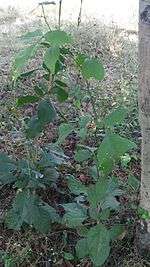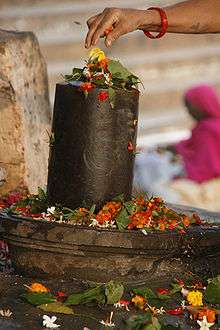Aegle marmelos
| Bael | |
|---|---|
_tree_at_Narendrapur_W_IMG_4116.jpg) | |
| Scientific classification | |
| Kingdom: | Plantae |
| (unranked): | Angiosperms |
| (unranked): | Eudicots |
| (unranked): | Rosids |
| Order: | Sapindales |
| Family: | Rutaceae |
| Subfamily: | Aurantioideae |
| Tribe: | Aurantieae |
| Subtribe: | Balsamocitrinae |
| Genus: | Aegle |
| Species: | A. marmelos |
| Binomial name | |
| Aegle marmelos | |
| Synonyms[2] | |
| |
Aegle marmelos L., commonly known as bael (or bili[3] or bhel[4]), also Bengal quince,[2] golden apple,[2] Japanese bitter orange,[5] stone apple[6][7] or wood apple,[5] is a species of tree native to the Indian subcontinent and Southeast Asia.[2] It is present in Sri Lanka, Thailand and Malesia as a naturalized species.[2][8] The tree is considered to be sacred by Hindus. An extract from the plant, aegeline, used in manufacturing a weight loss dietary supplement (OxyElite) which has been associated with liver damage upon oral consumption, was at the origin of federal lawsuits in the United States beginning in 2015, resulting in the arrest of numerous people involved in the manufacturing and marketing of OxyElite.[9]
Botanical information
Phylogeny and anatomy

Bael is the only member of the monotypic genus Aegle.[8] It is a deciduous shrub or small to medium-sized tree, up to 13m tall with slender drooping branches and rather shabby crown.[10]
Bark
The bark is pale brown or grayish, smooth or finely fissured and flaking, armed with long straight spines, 1.2-2.5 cm singly or in pairs, often with slimy sap oozing out from cut parts. The gum is also described as a clear, gummy sap, resembling gum arabic, which exudes from wounded branches and hangs down in long strands, becoming gradually solid. It is sweet at first taste and then irritating to the throat.[7]
Leaf
The leaf is trifoliate, alternate, each leaflet 5-14 x 2–6 cm, ovate with tapering or pointed tip and rounded base, untoothed or with shallow rounded teeth. Young leaves are pale green or pinkish, finely hairy while mature leaves are dark green and completely smooth. Each leaf has 4-12 pairs of side veins which are joined at the margin.
Flower
The flowers are 1.5 to 2 cm, pale green or yellowish, sweetly scented, bisexual, in short drooping unbranched clusters at the end of twigs and leaf axils. They usually appear with young leaves. The calyx is flat with 4(5) small teeth. The four or five petals of 6–8 mm overlap in the bud. Many stamens have short filaments and pale brown, short style anthers. The ovary is bright green with an inconspicuous disc.
Fruit
_fruit_at_Narendrapur_W_IMG_4099.jpg)

The bael fruit typically has a diameter of between 5 and 12 cm. It is globose or slightly pear-shaped with a thick, hard rind and does not split upon ripening. The woody shell is smooth and green, gray until it is fully ripe when it turns yellow. Inside are 8 to 15 or 20 sections filled with aromatic orange pulp, each section with 6 (8) to 10 (15) flattened-oblong seeds each about 1 cm long, bearing woolly hairs and each enclosed in a sac of adhesive, transparent mucilage that solidifies on drying. The exact number of seeds varies in different publications.
It takes about 11 months to ripen on the tree and can reach the size of a large grapefruit or pomelo, and some are even larger. The shell is so hard it must be cracked with a hammer or machete. The fibrous yellow pulp is very aromatic. It has been described as tasting of marmalade and smelling of roses. Boning (2006) indicates that the flavor is "sweet, aromatic and pleasant, although tangy and slightly astringent in some varieties. It resembles a marmalade made, in part, with citrus and, in part, with tamarind."[11] Numerous hairy seeds are encapsulated in a slimy mucilage.
Range and ecology

Aegle marmelos is native across the Indian subcontinent and Southeast Asia, and is cultivated throughout Sri Lanka, Thailand and Malesia.[2] It occurs in dry, open forests on hills and plains at altitudes from sea level to around 1200m with mean annual rainfall of 570-2,000 mm.[7][8] It has a reputation in India for being able to grow in places that other trees cannot. It copes with a wide range of soil conditions (pH range 5-10), is tolerant of waterlogging and has an unusually wide temperature tolerance (from -7 °C to 48 °C).[8] It requires a pronounced dry season to give fruit. The tree is a larval foodplant for the following two Indian Swallowtail butterflies, the Lime butterfly Papilio demoleus, and the Common Mormon: Papilio polytes.
Food uses
The fruits can be eaten either fresh from trees or after being dried and produced into candy, toffee, pulp powder or nectar.[8] If fresh, the juice is strained and sweetened to make a drink similar to lemonade. It can be made into sharbat or Bela pana, a beverage. Bela Pana made in Odisha has fresh cheese, milk, water, fruit pulp, sugar, crushed black pepper, and ice. Bæl pana, a drink made of the pulp with water, sugar, and citron juice, is mixed, left to stand a few hours, strained, and put on ice. One large bael fruit may yield five or six liters of sharbat. If the fruit is to be dried, it is usually sliced and sun-dried. The hard leathery slices are then immersed in water. The leaves and small shoots are eaten as salad greens.
Chemical compounds
The bael tree contains furocoumarins, including xanthotoxol and the methyl ester of alloimperatorin, as well as flavonoids, rutin and marmesin; a number of essential oils; and, among its alkaloids, á-fargarine(=allocryptopine), O-isopentenylhalfordinol, O-methylhafordinol.[12] Aegeline (N-[2-hydroxy-2(4-methoxyphenyl) ethyl]-3-phenyl-2-propenamide) is a constituent that can be extracted from bael leaves.[13][14]
Aeglemarmelosine, molecular formula C16H15NO2 [α]27D+7.89° (c 0.20, CHCl3), has been isolated as an orange viscous oil.[15]
Aegeline and liver injury
Aegeline is a known constituent of the bael leaf and consumed as a dietary supplement with the intent to produce weight loss.[13][14] In 2013, the U.S. Food and Drug Administration (FDA), Centers for Disease Control and Prevention (CDC), the Department of Defense Armed Forces Health Surveillance Center, and Hawaii state and local health officials identified an outbreak of 97 persons with acute non-viral hepatitis that first emerged in Hawaii. Seventy-two of these persons had reported using the dietary supplement OxyElite Pro which contained aegeline.[13][16] FDA had previously taken action against an earlier formulation of OxyElite Pro because it contained dimethylamylamine, a stimulant that FDA had determined to be an adulterant when included in dietary supplements and could cause high blood pressure and lead to heart attacks, seizures, psychiatric disorders, and death.[16] USPlabs subsequently reformulated this product without informing FDA or submitting the required safety data for a new dietary ingredient.[16]
Doctors at the Liver Center at The Queen's Medical Center investigating the first cases in Hawaii reported that between May and September 2013, eight previously healthy individuals presented themselves at their center suffering from a drug-induced liver injury.[13][17] All of these patients had been using the reformulated OxyELITE Pro, which they had purchased from different sources, and which had different lot numbers and expiration dates, at doses within the manufacturer's recommendation.[13][17] Three of these patients developed fulminant liver failure, two underwent urgent liver transplantation, and one died.[13][17] The number of such cases would ultimately rise to 44 in Hawaii.[13][17] In January 2014, leaders from the Queen's Liver Center informed state lawmakers that they were almost certain that aegeline was the agent responsible for these cases,[18] but the mechanism of how aegeline may damage the liver has not been isolated.[13]

United States lawsuits
On November 17, 2015, the U.S. Department of Justice criminally charged USPlabs and several of its corporate affiliates and officers with eleven counts of charges for manufacturing and marketing products that threaten consumer health.[9] The charges surrounded an alleged conspiracy to import ingredients from China using false certificates of analysis and labeling, and lying about the ingredients' source and nature after inclusion in their products.[9] The various defendants surrendered or were arrested by the United States Marshals Service, and FDA and special agents from the U.S. Internal Revenue Service seized assets including investment accounts, real estate, and luxury and sports cars.[9] This capped a yearlong sweep of potentially unsafe or tainted supplements that resulted in civil injunctions and criminal actions against 117 manufacturers and/or distributors of dietary supplements and products falsely marketed as such but containing banned or unauthorized ingredients.[9] As of December 2016, USPlabs was awaiting federal trial on conspiracy and other criminal charges related to OxyElite.[19]
Religious beliefs
Bael is used in the ritual rites of Hindus.[20][21] Bael is considered as one of the sacred trees of Hindus.[22] Earliest evidence of religious importance of Bael appears in Shri Shuktam of Rig Veda which reveres this plant as the residence of goddess Lakshmi, the deity of wealth and prosperity.[23] Bael trees can be usually seen near the Hindu temples and their home gardens.[24] It is believed that Hindu deity Lord Shiva is fond of bael tree and its leaves and fruit still play a main role in his worship.[25]
In the traditional practice of the Hindu and Buddhist religions by people of the Newar culture of Nepal, the bael tree is part of a fertility ritual for girls known as the Bel baha. Girls are "married" to the bael fruit; as long as the fruit is kept safe and never cracks, the girl can never become widowed, even if her human husband dies. This is seen to be protection against the social disdain suffered by widows in the Newar community.[26]
References
- ↑ "genus Aegle". Germplasm Resources Information Network (GRIN) online database. Retrieved 20 June 2017.
- 1 2 3 4 5 6 7 "Taxon: Aegle marmelos (L.) Corrêa". GRIN Global, National Plant Germplasm System, US Department of Agriculture. 19 September 2017. Retrieved 16 March 2018.
- ↑ "FOI search results". flowersofindia.net. Retrieved 20 January 2016.
- ↑ Wilder, G.P. (1907), Fruits of the Hawaiian Islands, Hawaiian Gazette, ISBN 9781465583093
- 1 2 "M.M.P.N.D. - Sorting Aegle names". unimelb.edu.au. Retrieved 20 January 2016.
- ↑ "Bael: Aegle marmelos (L.) Correa". Philippine Medicinal Plants.
- 1 2 3 Orwa, C (2009). "Aegle marmelos" (PDF). Agroforestree Database:a tree reference and selection guide version 4.0. Archived (PDF) from the original on 9 May 2016.
- 1 2 3 4 5 Misra KK (1999). "Bael". NewCROP, the New Crop Resource Online Program, Department of Horticulture and Landscape Architecture, Center for New Crops & Plant Products, Purdue University, W. Lafayette, IN. Retrieved 20 January 2016.
- 1 2 3 4 5 "Justice Department and Federal Partners Announce Enforcement Actions of Dietary Supplement Cases: Criminal Charges Brought against Bestselling Supplement Manufacturer". US Department of Justice. 17 November 2015. Retrieved 3 March 2018.
- ↑ Gardner, Simon (2007). Field guide to forest trees of Northern Thailand. Bangkok: Kobfai Publishing Project. p. 102. ISBN 978-974-8367-29-3.
- ↑ Boning, Charles (2006). Florida's Best Fruiting Plants: Native and Exotic Trees, Shrubs, and Vines. Sarasota, Florida: Pineapple Press, Inc. p. 35.
- ↑ Rasadah Mat Ali; Zainon Abu Samah; Nik Musaadah Mustapha; Norhara Hussein (2010). Aegle marmelos (L.): In ASEAN Herbal and Medicinal Plants (page 107) (PDF). Jakarta, Indonesia: Association of Southeast Asian Nations. p. 43. ISBN 978-979-3496-92-4. Archived (PDF) from the original on 12 June 2017.
- 1 2 3 4 5 6 7 8 Chatham-Stephens K, Taylor E, Chang A, et al. (2017). "Hepatotoxicity associated with weight loss or sports dietary supplements, including OxyELITE Pro™ - United States, 2013". Drug Test Anal. 9 (1): 68–74. doi:10.1002/dta.2036. PMC 5579712. PMID 27367536.
- 1 2 Avula, B; Chittiboyina, A. G; Wang, Y. H; et al. (2016). "Simultaneous Determination of Aegeline and Six Coumarins from Different Parts of the Plant Aegle marmelos Using UHPLC-PDA-MS and Chiral Separation of Aegeline Enantiomers Using HPLC-ToF-MS". Planta Medica. 82 (6): 580–8. doi:10.1055/s-0042-103160. PMID 27054911.
- ↑ Laphookhieo, Surat (2011). "Chemical constituents from Aegle marmelos". J. Braz. Chem. Soc. [online]. 22: 176–178.
- 1 2 3 "FDA Investigation Summary: Acute Hepatitis Illnesses Linked to Certain OxyElite Pro Products". US Food and Drug Administration. 30 July 2014. Retrieved 19 November 2015.
- 1 2 3 4 Roytman MM, Pörzgen P, Lee CL, et al. (August 2014). "Outbreak of severe hepatitis linked to weight-loss supplement OxyELITE Pro". Am J Gastroenterol. 109 (8): 1296–8. doi:10.1038/ajg.2014.159. PMID 25091255.
- ↑ Daysong, Rick (January 28, 2014). "Months after recall, new OxyElite Pro illnesses reported". Hawaii News Now. Retrieved 19 November 2015.
- ↑ "December 7, 2016: GNC Enters Into Agreement with Department of Justice to Improve Its Practices and Keep Potentially Illegal Dietary Supplements Out of the Marketplace". Office of Criminal Investigations, US Food and Drug Administration. 7 December 2016. Retrieved 3 March 2018.
- ↑ Peg, Streep (2003). Spiritual Gardening: Creating Sacred Space Outdoors. New World Library. ISBN 9781930722248.
- ↑ Bakhru, HK (1995). Foods That Heal. Orient Paperbacks. pp. 28–30. ISBN 9788122200331.
- ↑ Panda, H (2002). Medicinal Plants Cultivation & Their Uses. Asia Pacific Business Press Inc. p. 159. ISBN 9788178330969.
- ↑ The Astrological Magazine, Volume 92. Raman Publications. 2003. p. 48.
- ↑ S.M. Jain, K. Ishii (2012). Micropropagation of Woody Trees and Fruits Volume 75 of Forestry Sciences. Springer Science & Business Media. ISBN 9789401001250.
- ↑ Lim, T. K. (2012). Edible Medicinal And Non-Medicinal Plants: Volume 4, F0000000000ruits Volume 4 of Edible Medicinal and Non-medicinal Plants: Fruits. Springer Science & Business Media. p. 613. ISBN 9789400740532.
- ↑ Gutschow, Niels; Michaels, Axel & Bau, Christian (2008). "The Girl's Hindu Marriage to the Bel Fruit: Ihi and The Girl's Buddhist Marriage to the Bel Fruit: Ihi". Growing Up—Hindu and Buddhist Initiation Ritual among Newar Children in Bhaktapur, Nepal. Wiesbaden, GER: Otto Harrassowitz Verlag. pp. 93–173. ISBN 3447057521.
| Wikimedia Commons has media related to Aegle marmelos. |